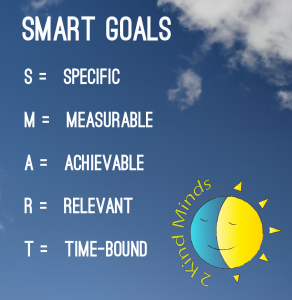
Use SMART Goals in every Area of your Life
SMART Goals are goals that fulfill a five criteria. These goals were originally invented by a management consultant in the 80’s who wanted to find a more efficient way to write management goals. Although SMART goals were invented for use in the business world, millions of people apply them in all areas of life. The letters of the word “SMART” stand for “S” as in specific, “M” for measurable, “A” for achievable, “R” for relevant and “T” for time-bound.

Let’s look at the concept, using an example:
Imagine that Sarah would like to spend more time on her well-being by practicing relaxation techniques. She has tried to create a habit of spending a few hours per week focusing on her mental well-being before, but the habit never seemed to stick.
This time she is trying to form a SMART goal. She decides that she wants to spend 2 hours per week on a relaxation practice such as progressive muscle relaxation or guided visualization. She knows from experience that she is most stressed and unmotivated on Mondays and Wednesdays, and decides to make time for 1 hour of relaxation exercises on these two days. To find out whether the exercises worked she decides to assess her stress levels on a scale from 1 to 10 before and after each practice. By doing that Sarah has created a SMART goal.
Specific: What exactly is your goal?
You should be able to tell exactly what your goal is. So be specific in formulating it. You know that your goal is specific when you can summarize it in one sentence that includes the outcome, and what techniques you will use to reach the outcome.
Example: “To feel more relaxed, I want to spend 1 hour on Monday and 1 hour on Wednesday by using relaxation exercises”. This goal is specific, because Sarah knows exactly when and how to start her new relaxation routine.
Measurable: How can you tell you are progressing towards your goal?
Being able to put your progress in numbers will help you keep track of how far you are on your path of reaching your goal. We recommend that you find a way to quantify your progress.
Example: The goal is measurable, because she knows when she achieved her goal in two ways: She reaches her goal when she finishes her relaxation exercises on Monday and Wednesday after 60 minutes. She also knows how effective the exercises were, by looking at her self-assessment.
Achievable: Can you reach your goal with the resources available to you?
It is logical that you are only able to reach your goal, if you have everything required to do so. Before you start working towards it, ask yourself: “Do I have everything I need to reach my goal?”. Resources vary greatly from person to person, and can include physical tools, mental and social resources as well as the available time. What you need to achieve your goal depends on what kind of goal you set and on which resources you have available to you.
Example: Sarah’s goal is achievable, because she knows to block out the necessary time on Mondays and Wednesdays and prepares everything she needs beforehand, such as getting the equipment ready and muting her phone to stop it from interrupting her.
Relevant: Is the goal important for the path you have chosen for yourself?
A goal is relevant when we know for certain that it is important for us. Usually we start with setting a goal when we have a problem that we want to solve. If your goal is a solution or a clear step towards finding a solution for a problem you want to solve, your goal is most likely relevant. Make sure you check every now and then and ask yourself whether your goal is still relevant. Our goals and motives change over time, so adjusting them will stop you from wasting unnecessary energy and time.
Example: The goal is very relevant to her, because she wants to improve her mental well-being and knows from experience and research articles she read, that these relaxation exercises help her achieve that.
Time-bound: What time frame will you require to reach your goal?
It is easy to lose track of projects when there is no specific time frame and deadline for finishing them. This is why it is best to have a reasonable plan for how long it will take you to complete the goal. Take into account that tasks will take up the time that they are given, which is explained by Parkinson’s law. It is therefore important that you give yourself enough time to realistically complete the task, but not too much that you are likely to procrastinate on it.
Example: Sarah’s goal is time-bound, because it is reached each week after Wednesday’s practice, and starts again in the following week on Monday. She also knows exactly on which days to practice.
The technique of setting yourself SMART goals can be extremely helpful in reaching bigger, complex goals in all areas of your life. By adding smaller sub-goals you know at any point what your next step should be to get closer to achieving it. Coming up with appropriate sub-goals depends on you and your working style and it is recommended that you adjust your goal when you feel that it has changed, or something is not working for you.
When you first start applying SMART goals you might find it a little difficult, but you will soon get used to the procedure and making sure the goal fits the criteria will become easier over time.
If you would like some help with getting started, you can book a 1-on-1 session with us and we will figure out a way for you to get closer to your goals. Another option is to participate in our 5-week course on building sustainable routines that will help you put new routines into place and set yourself SMART goals to help you on your way.
Photo by Stéphane Fellay on Unsplash